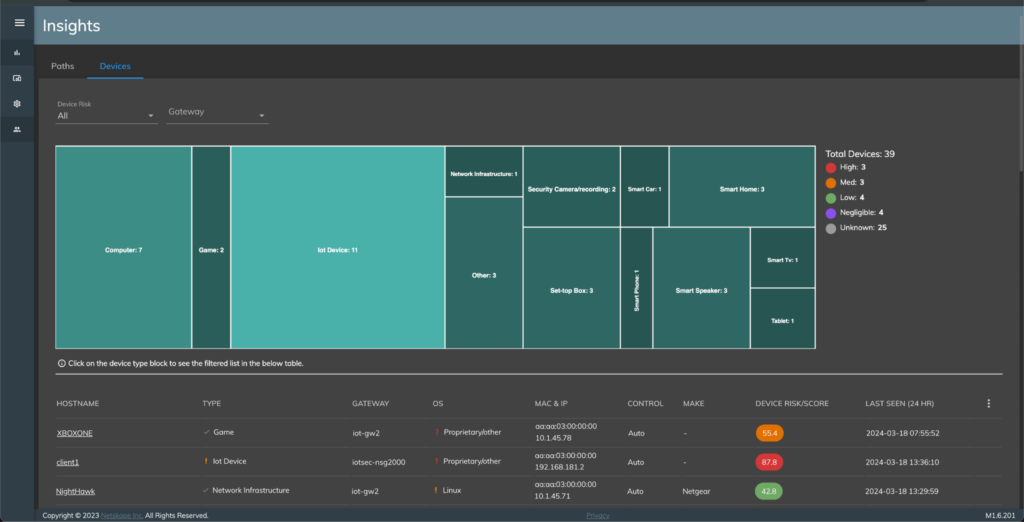Imagine a future where office coffee machines autonomously order beans, and both comfort and energy efficiency are effortlessly managed through smart lighting and temperature controls, alongside smart factories leveraging robotic arms for optimal production. With the internet of things (IoT) market expected to reach 55.7 billion devices by 2025, as predicted by IDC, this potential future brings thrilling opportunities and serious challenges. The emergence of IoT botnet attacks like Gafgyt and Mirai, responsible for massive DDoS disruptions, underscores the critical need for robust cybersecurity solutions across our interconnected environments, from home-offices to smart factories, ensuring our increasingly connected world remains secure.
Netskope modernizes branch connectivity and security with Next Gen SASE Branch by integrating Device Intelligence into Netskope One Gateway, a unified SASE platform. Leveraging AI/ML-powered Device Intelligence, Netskope One Gateway discovers and classifies all connected devices, managed and unmanaged. This unparalleled innovation provides unprecedented visibility across enterprise networks and branch offices, enabling them to be secured through context-driven classification, risk assessment, micro-segmentation, and access control.

Traditional SD-WAN solutions lack the intelligence and security needed for modern branches. 94% of IT experts dread the havoc unsecured IoT devices could wreak with data breaches.
Let’s explore challenges with traditional SD-WANs.
- Unseen Threats: The Battle Against Invisible Devices
Countless managed and unmanaged IoT devices silently operate within our networks, each a potential door for malicious actors and legacy SD-WAN struggle to discover them, let alone protect from them if they become rogue.
- Navigating the Complexity: Taming the Appliance Sprawl
Many deploy point solutions like IoT security appliances to meticulously categorize devices based on type, vendor, and operating system. Then to catch vulnerabilities, they stack on another security appliance. This layered approach, while seemingly secure, creates a growing cost and operational burden.
- Navigating through Manual Operations – Hard to Define Granular Policy
Traditional segmentation tools, like NACs and VLANs, struggle with the dynamic nature of IoT environments, as they rely on coarse-grained segmentation methods that hinge on static device information. For example, when new IoT devices join the network, traditional tools can’t dynamically recognize them, risking it with incorrect policies or overly broad access controls, compromising security and functionality.
- Balancing Connectivity and Control: Challenges of Diverse Corporate Environments
In today’s connected environments, instant access to critical data and rapid response times are crucial for maintaining network efficiency and reliability. However, unmanaged devices pose a significant challenge as they can potentially throttle network performance by consuming bandwidth essential for mission-critical corporate devices.
- Navigating Costly Troubleshooting with Truck Rolls that weighs down IT budgets
Issues do arise with all connected devices, but legacy SD-WAN at the branch lacks mechanisms for connecting, troubleshooting, or upgrading remotely, leading to costly on-site remediation delays.
Businesses Demand Next-Generation SASE Branch for IoT Security and Operational Simplification.
Netskope modernizes branch device connectivity and security through a dynamic, context-driven approach with the Netskope One Gateway, a unified SASE gateway that natively integrates IoT/OT Device Intelligence and security capabilities, facilitating the transition to a Next Gen SASE branch, eliminating point products, and streamlining operations.
Device Intelligence embedded within a unified SASE gateway, delivers the following:
- Discover and classify all connected devices automatically
The Netskope unified SASE gateway discovers any managed and unmanaged devices, within the branch and generates a rich device context/score using AI/ML for automated device classification after analyzing hundreds of parameters to match each device’s IP with its type, vendor and model, revealing more than 50 essential device attributes that profile the device. For example, a corporate-owned security camera may have a different risk score than a conferencing system.
- Preventing Threats from Spreading: Blocking High-Risk Devices
Netskope’s unified SASE gateway leverages AI/ML to dynamically assess devices’ security posture, context, and real-time risk. It also enables organizations to enforce integrated security rules based on computed risk scores. For instance, a camera initially classified as safe with a score of 95 could have its score automatically lowered to 50 and blocked if it starts communicating with a command and control server, indicating potential malicious activity.
- Unleashing the Power of Zero Trust Security with Micro-Segmentation
Netskope’s unified SASE gateway, with integrated Device Intelligence, offers comprehensive device context, encompassing device and device risks. This empowers organizations to swiftly detect breaches with integrated IDS/IPS running as a service and automatically implement micro-segmentation based on detailed attributes, preventing lateral movement of potential threats
- Assured application experience – Optimized Lanes for High-Priority Devices
Netskope SASE Gateway ensures a tailored application experience for each connected device with device context-aware AppQoE policies, guaranteeing optimal performance for high-priority applications. Device context from Netskope Device Intelligence is relayed to the SD-WAN orchestrator, allowing for prioritization of device requests. For instance, vital monitoring equipment traffic can be prioritized over gaming traffic from a user’s any device.
- Ensure Secure zero trust device access
Netskope’s SASE gateway offers proactive (Day 2) remote support by enabling zero trust secure access to devices within the branch, such as phones, ATMs, and servers, via protocols like HTTP, RDP, SSH, and VNC facilitating efficient incident resolution. Support teams securely connect to high-value assets from the SASE Orchestrator, ensuring secure remote access without compromising operational costs or exposing vulnerabilities.
Conclusion
As we move deeper into the era of unprecedented connectivity, the burden of securing ever-growing connected devices weighs heavily. Unsecured IoT devices and outdated SD-WAN systems introduce new vulnerabilities.
Fear not! Netskope’s Next Gen SASE Branch that is powered by a unified SASE gateway provides a transformative solution, utilizing integrated device intelligence and security capabilities as services, alongside dynamic micro-segmentation, to tackle these challenges while simplifying the branch stack. By automatically discovering and classifying all connected devices, enforcing firewall rules based on real-time risk assessments, and prioritizing mission-critical corporate devices, Netskope ensures a secure and optimized network environment, fostering higher productivity. With proactive support for secure zero-trust device access, Netskope empowers organizations to navigate the complexities of modern networking confidently and efficiently.
Ready to transform! Explore how Netskope’s Next Gen SASE Branch can help accelerate your SASE journey.




 Back
Back

















 Read the blog
Read the blog